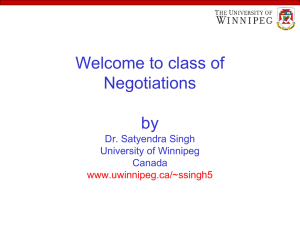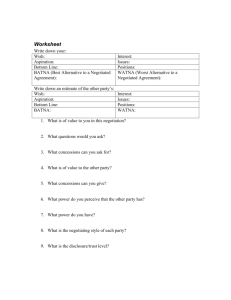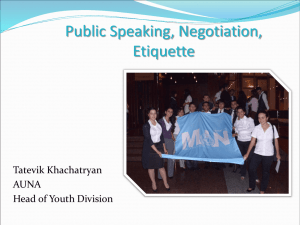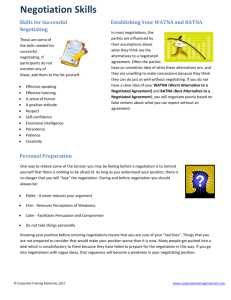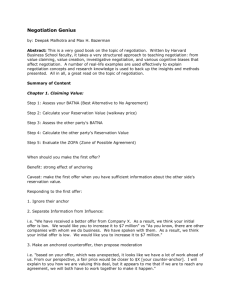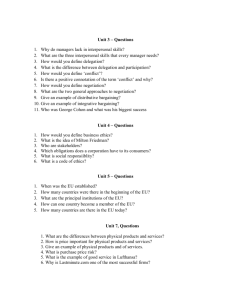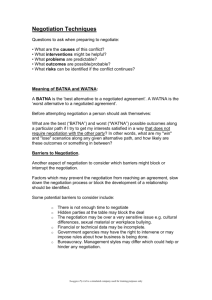NEGOTIATION PREPARATION GUIDE 1. Establish Open
advertisement
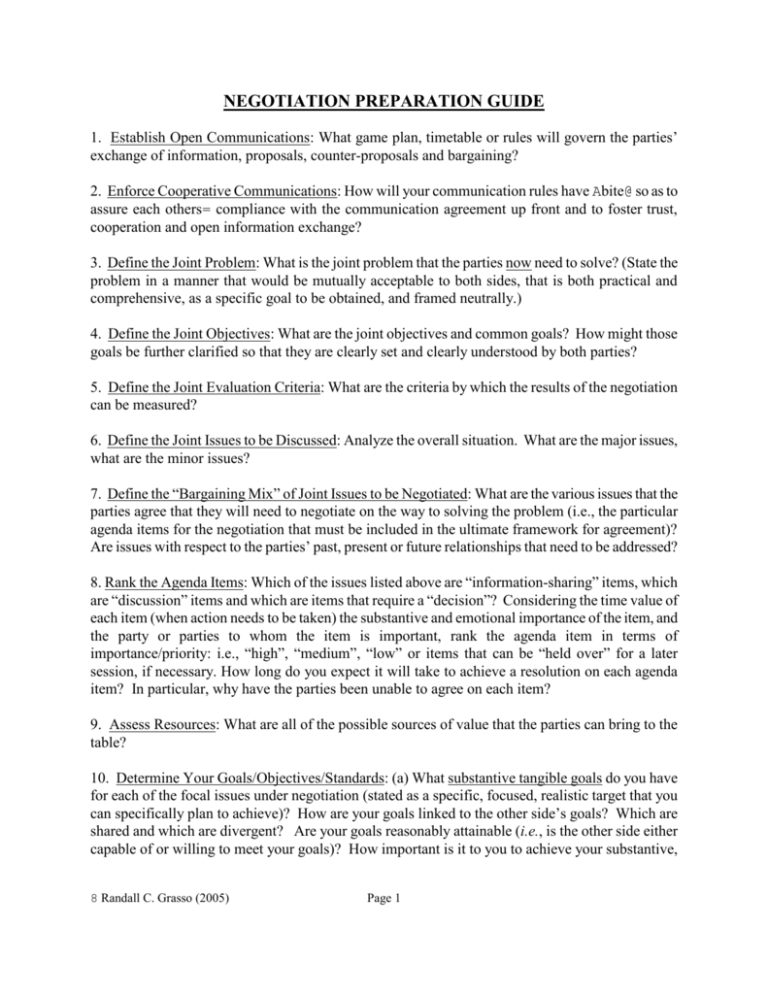
NEGOTIATION PREPARATION GUIDE 1. Establish Open Communications: What game plan, timetable or rules will govern the parties’ exchange of information, proposals, counter-proposals and bargaining? 2. Enforce Cooperative Communications: How will your communication rules have Abite@ so as to assure each others= compliance with the communication agreement up front and to foster trust, cooperation and open information exchange? 3. Define the Joint Problem: What is the joint problem that the parties now need to solve? (State the problem in a manner that would be mutually acceptable to both sides, that is both practical and comprehensive, as a specific goal to be obtained, and framed neutrally.) 4. Define the Joint Objectives: What are the joint objectives and common goals? How might those goals be further clarified so that they are clearly set and clearly understood by both parties? 5. Define the Joint Evaluation Criteria: What are the criteria by which the results of the negotiation can be measured? 6. Define the Joint Issues to be Discussed: Analyze the overall situation. What are the major issues, what are the minor issues? 7. Define the “Bargaining Mix” of Joint Issues to be Negotiated: What are the various issues that the parties agree that they will need to negotiate on the way to solving the problem (i.e., the particular agenda items for the negotiation that must be included in the ultimate framework for agreement)? Are issues with respect to the parties’ past, present or future relationships that need to be addressed? 8. Rank the Agenda Items: Which of the issues listed above are “information-sharing” items, which are “discussion” items and which are items that require a “decision”? Considering the time value of each item (when action needs to be taken) the substantive and emotional importance of the item, and the party or parties to whom the item is important, rank the agenda item in terms of importance/priority: i.e., “high”, “medium”, “low” or items that can be “held over” for a later session, if necessary. How long do you expect it will take to achieve a resolution on each agenda item? In particular, why have the parties been unable to agree on each item? 9. Assess Resources: What are all of the possible sources of value that the parties can bring to the table? 10. Determine Your Goals/Objectives/Standards: (a) What substantive tangible goals do you have for each of the focal issues under negotiation (stated as a specific, focused, realistic target that you can specifically plan to achieve)? How are your goals linked to the other side’s goals? Which are shared and which are divergent? Are your goals reasonably attainable (i.e., is the other side either capable of or willing to meet your goals)? How important is it to you to achieve your substantive, 8 Randall C. Grasso (2005) Page 1 tangible goals? Why are those goals important to you? What does it do for you to obtain that goal? Would it make sense to an objective, neutral third party that you should want these goals? (b) What process-based goals do you want to achieve in the manner in which the dispute is settled? Why are those goals important to you? What does it do for you to obtain that goal? (c) What intangible, relationship-oriented goals do you want to achieve? How important is it to your side to maintain the current and future quality of the relationship with the other party? Why are those goals important to you? What does it do for you to obtain that goal? (d) With respect to each goal, what underlying principles or standards do you want to adhere to or the norms by which you will negotiate and the benchmarks that you will use to guide you to settlement? Why are those standards and norms important to you? 11. Review Other Aspirations: In addition to the foregoing, what other important interests, needs or concerns must be satisfied for your side for there to be a satisfactory resolution? How would you rank them in importance (essential, high, moderate, low)? 12. Other Concerns: Rights: How important is it to either side to be Aright@Cthat is, to have it determined who has legitimacy, who is correct or what is Afair@? Why is that important? What independent, objective, principles, standards or rules could both parties agree are the benchmarks that will guide them toward settlement? 13. Other Concerns: Acknowledgment of Harm Done/Apology: How important is it to either side for the other party to acknowledge some particular act or omission on their part that triggered the conflict? Is an apology in order? Is an expression of regret in order? Is a request for forgiveness in order? Who should make it, and why? Is that person capable or willing to make such a statement? Why or why not? 14. Other Concerns: Relationships: Is this conflict a single-encounter dispute? Is there an ongoing relationship between the parties? What type of relationship do the parties desire at the end of the dispute? What interest/need is there by either party to maintain an ongoing relationship with the other? How will either side=s approach to this conflict resolution affect their ongoing relationship? How will either side=s approach to this conflict resolution affect future conflicts of this type? 15. BATNA Your Best No-Deal Alternative: What is your BATNA (best alternative to a negotiated agreement) for accomplishing your important goals or objectives if you are unable to reach an agreement with the other side? What other deals can you achieve (with the other side or with others) and still meet your needs? What resources do you have available to meet your needs other than by dealing with the other side? How strong/weak is your best alternative to doing a deal with your counterpart? How much do you want/need to do a deal with your counterpart? 16. Setting Your BATNA: Situational Leverage in General: How able are you in this situation to satisfy the purposes (goals, desires or wants) that you are attempting to fulfill? (Consider your ability to accumulate and present data, expertise or information to change the other side’s point of view or position on an issue; consider your ability to accumulate money, raw materials, time, equipment, etc. as an incentive to encourage compliance or punish non-compliance; consider your 8 Randall C. Grasso (2005) Page 2 position in an organization as formal authority or access to or control over information or resources). How powerful do you think the other side thinks you are? What might happen to limit your power? 17. Setting Your BATNA: Situational LeverageCThe Cost of No Agreement: What are the costs to each side of pursing this matter if you do not reach an agreement (Attorney fees, Litigation Expenses, Salary, Lost Business, Delay, Disruption, Lost Opportunity other Economic Pressures)? Which side is more able to impose economic pressure on the other? 18. Setting Your BATNA: Situational LeverageCThe Time Penalty of No Agreement: How long will it take to settle this dispute if you do not do it through negotiation? Is a rapid or delayed settlement desirable? Are there any critical deadlines or time constraints to be considered? Does a deadline pose an opportunity or a crisis for either party? What is the most advantageous time to settle? Does any party need more time to mobilize resources or to build credibility and commitment among a constituency for a particular course of action? Which side is more able to impose time pressure on the other? 19. Setting Your BATNA: Situational LeverageCRisk Aversion: What are the parties’ differing attitudes about risk? What is each party=s present need for money? What are your concerns if you could not do a deal or if your alternative is not attractive? How would you quantify your regret or sense of loss if you could not do a deal? Based on your previous answer, what would you be willing to give up just to have certainty? (Discount factor). 20. Setting Your BATNA: Situational LeverageCUncertainty About the Future: What are the key uncertainties in this matter? Which are the most or least important? How can you better assess the uncertainties? What is the cost to you to obtain information to assess the uncertainty? Which uncertainties will clear up over time? Are your beliefs about the uncertainties (risk assessment) different from those of your counterpart? What does your counterpart know about the uncertainties that you don not? Can you exploit the different assessment of uncertainty in the way that you structure your offer to your counterpart? 21. Setting Your BATNA: Your Legal Strengths/Weaknesses: What are your side=s legal strengths (law, witnesses, evidence, procedure)? What relevant arguments can you make to support your own position? What are your side’s legal weaknesses? What can you do to strengthen your weaknesses? 22. Setting Your BATNA: (For Pure Monetary Litigated Disputes, Only): What is the Expected Monetary Value of the lawsuit? FSV=[(PAV + INT + PAF) X PPV] - [(DAV + INT + DAF) X DPV] - UC - PC + DC +/- I FSV means “fair settlement value” PAV means “plaintiff’s average verdict,” objectively estimated using experience and jury verdict research INT means “prejudgment interest” 8 Randall C. Grasso (2005) Page 3 PAF means “plaintiff’s attorney fees,” if recoverable. PPV means “plaintiff’s probability of a verdict,” given the likelihood of the court giving favorable instructions and jury’s answering those questions favorably to plaintiff DAV means, in the event of a counterclaim, “defendant’s average verdict,” objectively estimated using experience and jury verdict research INT means, in the event of a counterclaim, “prejudgment interest” DAF means, in the event of a counterclaim, “defendant’s attorney fees,” if recoverable DPV means, in the event of a counterclaim, “defendant’s probability of a verdict,” given likelihood of the court giving favorable instructions and the jury answering those liability questions favorably to defendant UC means the “uncollectible” portion of any judgment PC means “plaintiff’s costs” from this point forward to ultimate payout DC means “defendant’s costs” from this point forward to ultimate resolution I means “intangibles” represented by a dollar amount reflecting factors that enhance or detract from the value of the plaintiff’s case in the eyes of the jury. Calculate “FSV” and determine an amount +/- 10% of FSV to obtain a realistic, objective “settlement range” of pure monetary disputes. 23. The Players: Potential Barriers to Negotiation: Apart from having incompatible goals or outcomes, are there any strong negative feelings that are driving the parties apart, thereby making agreement more difficult? What are those feelings? Is there a lack of trust between the parties? Why do you think that you cannot depend on or place confidence in the truthfulness of the other side’s actions or behavior? Are there any problems with perceptions of the legitimacy of the other side or the other side’s issues, interests or emotions? What must be discussed/aired out before the parties can decide on an agreement of restitution and/or a plan for the future? 24. The Players: Your Negotiation Style: What is your side’s approach to this particular negotiation as a strategy for satisfying your interests (Competitive, Cooperative, Accommodating, Avoiding)? Given the importance to your side of the substance of the negotiation and the parties’ relationship, is your side’s interest better served by competing with the other side in court, by avoiding the matter, by giving in to what the other side wants, by a negotiated compromise (a “divide the pie” solution), or by an integrative, cooperative “expand the pie” solution? 25. The Players: Constituents: Is the configuration of the parties complete? Should another party be present at the table? [Is this an insurance case? Is liability disputed? Will the defendant insured be present? Does the other side expect the defendant insured to be present?] Are competing expert opinions involved? Will the experts be present? Would their presence be helpful? Are there any non-party stakeholders like other organization members, family members or management superiors who should attend to reach a settlement? Is their inclusion necessary to reach a settlement? If they don’t attend, could they later derail any agreement reached? To whom are you accountable for the results of the mediation? Will you have to report back on the outcome to a superior? How will that affect the way you carry out your role in the mediation? 8 Randall C. Grasso (2005) Page 4 26. The Players: Commitment: Is your side psychologically prepared to commit itself to a particular dispute resolution approach (Competitive, Cooperative, Accommodating, Avoiding/Stalemating). Is your side satisfied with the approach now being used or are you ready to try a different way? Does a coordinated, cooperative approach with the other side offer you any advantage? Do you have sufficient influence, power and resources that you can effectively use to carry out a coordinated, cooperative conflict resolution approach? 27. The Players: Prior Settlement Negotiations: What is the history of prior settlement negotiations? Why do you think that they did not succeed? Is a settlement possible now? What is your expectation of each side’s starting point, and whose turn is it to go? 28. Preparing to Bargain: Create Your Issue Matrix: On a separate sheet, rank order all issues according to their true importance to you. It=s not just what you say that you want, but what you would really choose and why. Assign points to the issues in order of importance to you so that they all add up to some large round number, such as 100. List the range of different possible settlements/outcomes for each issue. (Identify the ranges by using industry or local norms or your best assessment of realistic high, low and other interim expectations.) For each issue, label different outcomes something like Initial, Target, Limit and BATNA. Assign points to the possible outcomes that you identified for each issue. Assign the maximum points to the preferred outcome and 0 points to the least acceptable outcome (BATNA). Rank and assign points to the interim outcomes based on your reasoned satisfaction appraisal of that outcome. For instance, if you gave an issue 40 points the preferred outcome for you would get all 40 points, your Acontent with@ or target outcome might get 25 points, for example, and the least acceptable outcome would get a number approaching 0. The other outcomes of that issue would get between 1 and 39 points depending on your satisfaction level with those other possibilities. Check your scoring system by looking at 3 - 5 hypothetical packages of agreements for your Initial, Target and Limit packages while emphasizing different issues (i.e., tradeoffs between issues in an equivalently valued package). Compare the different agreements on the basis of points and your reasoned, intuitive satisfaction level for that package. Packages of equivalent values should be equally satisfying to you. The best practical “gut feel” agreement should have the most points. If it does not, adjust your issue preferences and your satisfaction levels. Use this scoring system to assess any proposal that you make or that you receive. Initially, try to get the highest scoring agreement that the other side will allow. Are any of the issues linked to any other issues? Should some issues be “clumped”? Should some issues be separated? On which issues must you stand firm? On which issues can you afford to concede or trade? How competitive or cooperative are you willing to be based in part on how important it is to maintain a good relationship with your counterpart)? Consider what kinds of deals can be done on the individual negotiating points that would “unlock” the most value for the negotiators at large. 29. Setting Your Limit: Considering the foregoing, and subject to receiving new information that causes you to re-assess your strategy, where will you decide that you should stop the negotiation 8 Randall C. Grasso (2005) Page 5 rather than continue because any settlement beyond that point is not minimally acceptable? (This should be something slightly better than the value of your BATNA.) 30. Setting Your Target: Using the issue matrix and keeping in mind your own objectives, where do you realistically expect to achieve a deal with the other side? (What is an outcome/package that you would be comfortable with? At what point would you generally be satisfied? As a reference point or norm, consider what have others achieved in the same situation.) Can you state your target as a general range or a class of several outcomes/packages that would be equally acceptable? Considering the overall mix of bargaining objectives, what different equivalent proposals can you make that would help you achieve your objectives on the issues that you deem most important? (Consider some more conservative targets for the less important issues. Consider your trade-offs and your throw-aways. Create some equivalently-valued packages from your issue matrix.) 31. Fairness Argument: Why is your target fair? (What fairness norms justify your proposal? What are some objective criteria [equitable, moral, legal standards] that would appeal to a neutral outsider and that you can invoke with your counterpart to support your proposal? Is your proposal in line with other deals involving similar issues or under similar circumstances? Would those whom you respect in the community or a jury perceives your proposal as being fair to both sides?) Do you have the power to force the other side to accept your proposal? Putting yourself in the other side’s shoes, why should your counterpart see your proposal as fair? Why would your counterpart think that your proposal is not fair? What fairness norms can your counterpart invoke to support their proposal to you? In response to your proposal, will your counterpart press you for more concessions or will they push you to accept their last offer as being the most fair? 32. Setting Your Opening: What is your opening “bid”? (Assuming no prior negotiation history between the parties, consider the best possible, yet realistic, outcome for you; an ideal solution; or something even better than what was achieved the last time that you were confronted by a similar situation. However, do not inflate your opening to the point where it becomes self-defeating because it is too unrealistic in the eyes of the other negotiator.) Consider making Multiple Equivalent Simultaneous Offers (MESOs). Using your scoring matrix, create an initial package of 3 equivalently valued MESOs that stress different issues and are more aggressive than your Target. These should anchor the negotiation in your favor, but will also signal flexibility and will support your negotiating reputation.. 33. Principled Reasons to Support Your Opening: Why is your opening bid credible? Why does it “make sense”? What are the logical rationales that support and explain each component of your opening offer? Why did you choose the position that you selected rather than a less beneficial (to you) starting point? Be prepared to explain your opening to the other side. Will they see it as a realistic possibility for you, or will they dismiss it as “wishful thinking”? 34. Concession Strategy: What is your concession pattern going to be? What principled reasons will you give for moving off of your initial opening and to explain why that concession is being made? Avoid inexplicable jumps. 8 Randall C. Grasso (2005) Page 6 THE OTHER SIDE 35. Determine the Other Side’s Goals/Objectives and Importance: What do you understand to be the other side’s tangible and intangible goals? What is really important to them? Why is it important to them? What needs of their must be satisfied before they can reach a settlement with you? Is this something that you are capable or willing to do or to give? What interests of the other side do you share? 36. Determine the Other Side’s Current Resources and Needs: What value can the other side bring to the table? What do they need that you could provide? What type of package could you create that unlocks hidden value for you at little cost to the other side or for the other side at little cost to you? 37. Leverage: The Other Side’s BATNA: What is the other side’s best alternative method for accomplishing their important goals or objectives if they are unable to reach an agreement with you? What other deals can they achieve (with you or with others) and still meet their important needs? What resources do they have available to meet their needs other than by dealing with you? How strong/weak is their best alternative to doing a deal with you? How much do they want/need to do a deal with you? 38. Leverage: The Other Side’s Situational Power: How able is the other side in this situation to satisfy the purposes (goals, desires or wants) that they are attempting to fulfill? (Consider their ability to accumulate and present data, expertise or information to change your point of view or position on an issue; Consider their ability to accumulate money, raw materials, time, equipment, etc. as an incentive to encourage compliance or punish non-compliance; Consider their position in an organization as formal authority or access to or control over information or resources). What might happen to limit their power? 39. Leverage: The Other Side’s Legal Strengths/Weaknesses: What are the other side=s legal strengths (law, witnesses, evidence, procedure)? What relevant arguments can they make in support of their position? What are their legal weaknesses? What can they do to strengthen their weaknesses? 40. The Players: The Other Side=s Negotiation Style: How would you describe the other side’s approach to this particular negotiation as a strategy for satisfying their interests (Competitive, Cooperative, Accommodating, Avoiding/Stalemating)? Given the importance to the other side of the substance of the negotiation and the parties’ current or desired relationship, is the other side’s interest better served by competing with you in court, by avoiding the matter, by giving in to what you want, by a negotiated “divide the pie” compromise, or by an integrative, cooperative “expand the pie” solution? 41. The Players: The Other Side’s Representatives and Authority: Will the appropriate party representatives attend in person? With this include the key decision makers? Will they have sufficient authority to reach a settlement? Do they know and understand the issues in dispute? Do 8 Randall C. Grasso (2005) Page 7 they understand the mediation process? Do they have good negotiating skills? Are they competitive or cooperative, accommodating or avoiding? Can they control their emotions? Are they acceptable to you? Are they committed or are they willing to commit to bargaining in good faith and seeking mutually acceptable solutions? Are they motivated to settle the dispute? 42. Bargaining: The Other Side’s Limit: Given the foregoing, what is the point where you believe the other side will decide that they should stop the negotiation rather than continue because any settlement beyond that point is not minimally acceptable to them? What type of a package could you propose to test this? 43. Bargaining: The Other Side’s Target: Thinking about the other side’s interests, objectives and resources from their point of view, what do you think is their target? What type of a package could you propose to test this? Why would their target be “unfair” or something that you cannot accept? What would they have to change before you could accept their target? 44. Bargaining: The Other Side’s Likely Arguments Supporting Their Point of View: 45. Bargaining: The Other Side’s Opening: Putting yourself in the other side’s shoes, and using the same criteria as for you, where do you expect them to (credibly) open? What support do you expect them to muster? 46. Bargaining: The Other Side’s Strategy and Tactics: Ho can you turn this negotiation from a strategic game to a considered joint deliberation about ends? How will you build trust, cooperation, respect and commitment to open communication? VALUE CREATION 47. Creative Options: What suggestions do you have for creative paths to resolve this dispute in a matter that is most likely to meet most of each side’s interests? Is there a way to settle this case that does not involve the payment of money? Considering the agreed deal issues, what are all of the possible sources of value that the parties can bring to the table? What is the largest possible “pie” that the parties can create together? What is the outer limit of feasible agreements that the parties can jointly make? What interests do the parties share? How can value be created out of what both parties want? 48. Trade-offs: What trade-offs are possible to build the most value within each agreed deal issue? What trade off packages can one side propose to the other to understand that the other side really values and where mutual gains can be identified? Do the parties have different interests or divergent expectations as to time, risk or probability of future events? How can the parties create value out of their different expectations? 49. Mini-deals and Iteration: How can mini-deals be combined with one another or packaged to find further trade offs and value between them? Use mini-deals to create and then claim value iteratively. What is the best possible overall agreement that the parties can jointly create? 8 Randall C. Grasso (2005) Page 8 50. Evaluation: Evaluate the benefits of the deal from an objective point of view after the deal is done. 8 Randall C. Grasso (2005) Page 9
